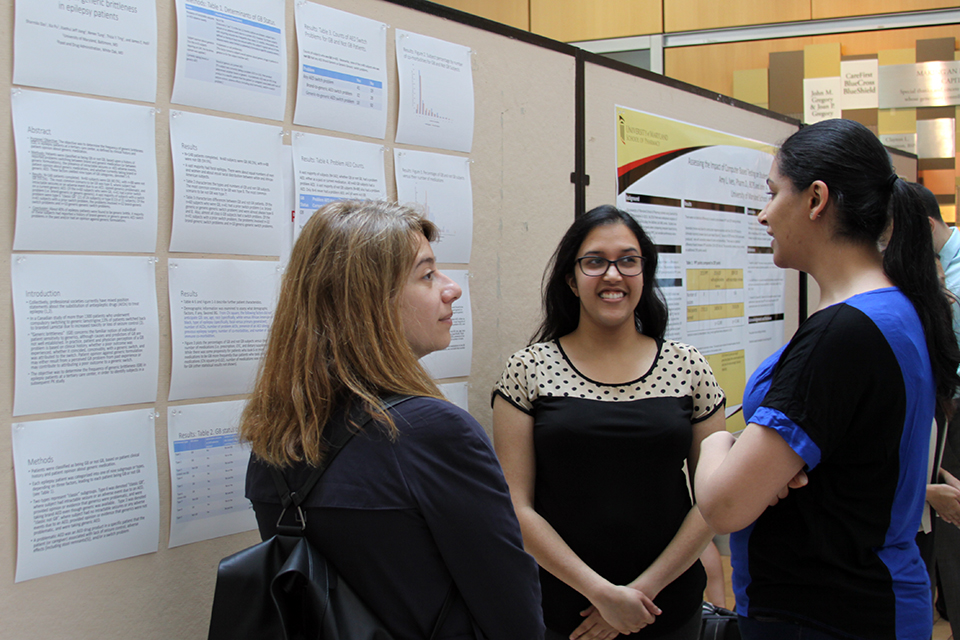DuMez Lecture Spotlights Pharmaceutical Treatments for Addictive Disorders
Speaker Frank Vocci addresses the history and development of medications used to treat individuals with substance abuse disorders.
By Malissa Carroll
April 19, 2013
Frank J. Vocci, PhD ’77, president and senior research scientist at the Friends Research Institute, delivered the annual Andrew G. DuMez Memorial Lecture at the University of Maryland School of Pharmacy on April 8. His lecture, titled “The Interplay of Dose and Dosage Form in the Development of Medications to Treat Addictive Disorders,” examined the evolution of pharmaceutical treatments available to individuals with substance abuse disorders, particularly those addicted to opioids, including illicit drugs such as heroin and prescription painkillers such as oxycodone.
Vocci spent 11 years at the Food and Drug Administration (FDA) where he reviewed applications for the marketing of analgesic (painkiller) medications and medications for the treatment of substance abuse disorders. In 1989, he joined the Medications Development Program at NIDA, and became the director of the Division of Pharmacotherapies and Medical Consequences of Drug Abuse (DPMC) in 1997. During his tenure, the DPMC collaborated on the development of multiple addiction drug products.
One addiction drug product to which Vocci made significant contributions was buprenorphine, which was first marketed as a painkiller in 1982.
“A clinical pharmacology study conducted at the Addiction Research Center in Lexington, Kentucky, found that one of the unique properties associated with buprenorphine was a lack of withdrawal symptoms,” said Vocci. “Researchers used the Himmelsbach Withdrawal Scale to look for symptoms that would indicate withdrawal in participants, and when compared to 40 other opioid drugs that were tested, buprenorphine had the lowest withdrawal score. It also reduced cravings for opiates over a four-week period.”
Vocci noted that there were three pivotal studies that led to the approval of buprenorphine as a long-term replacement therapy for opiate-dependent patients in 2002. With the passage of the Drug Addiction Treatment Act of 2000, which allowed qualified physicians to treat individuals with opiate dependence in an office-based setting using Schedule III, IV, and V narcotics, buprenorphine became one of the most highly marketed medications in the United States.
Vocci received a Distinguished Service Award from the College on Problems of Drug Dependence for his contributions to the development of buprenorphine as a treatment for opiate dependence in 2003.
Another addiction drug product on which Vocci collaborated was the depot form of naltrexone. Originally developed in 1967 by NIDA and DuPont Pharmaceuticals, the oral form of naltrexone was approved by the FDA in 1984, and has significantly contributed to the prevention of relapse in recovering health care professionals. The depot preparation (VIVITROL) was first approved in 2006 for the treatment of alcohol dependence, then in 2010 for the treatment of opioid dependence. He also commented on levacetylmethadol (LAAM) as another potential treatment option for individuals with substance abuse disorders. Though approved by the FDA in 1993, distribution of LAAM ceased after the FDA placed a black box warning in drug’s labeling due to reports of QT prolongation.
At the Friends Research Institute, Vocci continues to be interested in developing medications for the treatment of substance abuse disorders, and is currently working on two studies involving criminal justice clients. One of his studies involves evaluating the administration of depot naltrexone to formerly opiate-dependent prisoners prior to release and then for six months post-release. Another protocol is attempting to determine whether training parole and probation officers on the features and benefits of medications and assisted therapy results in more referrals of drug-dependent criminal justice clients to clinics that dispense such therapies.



